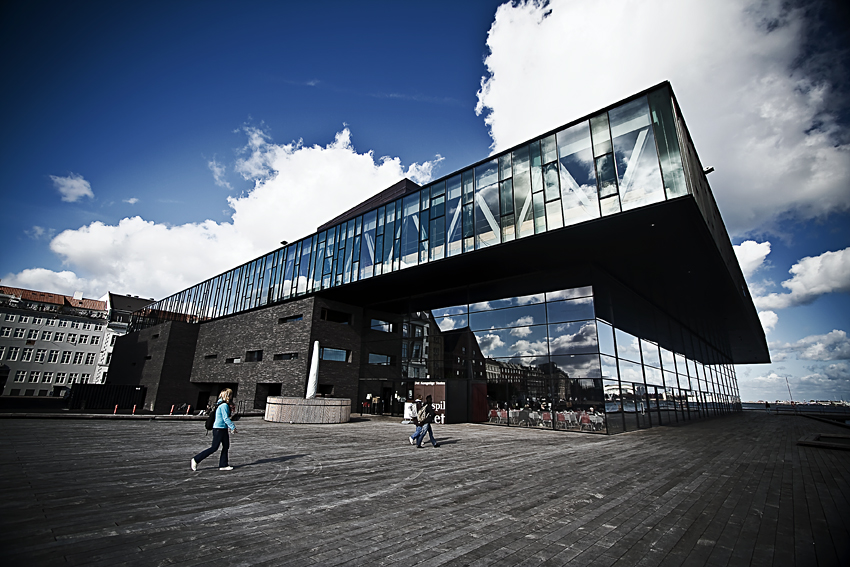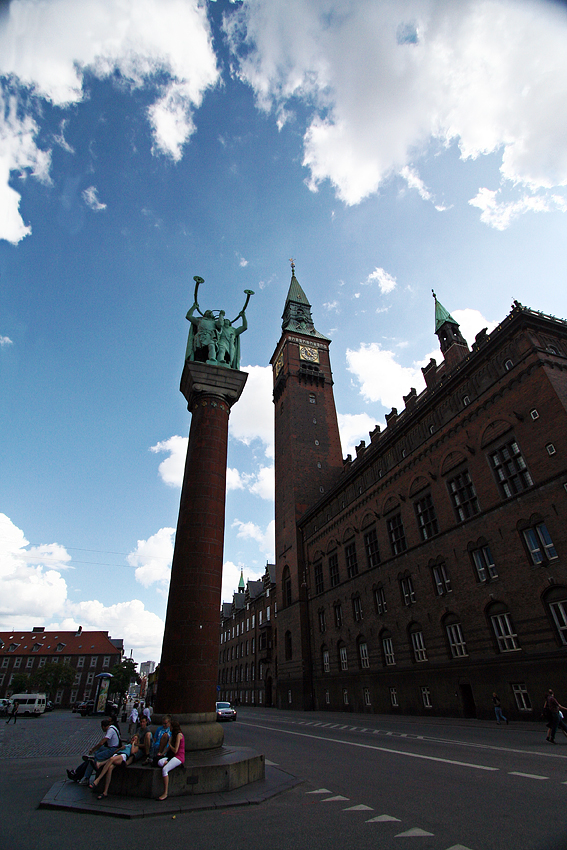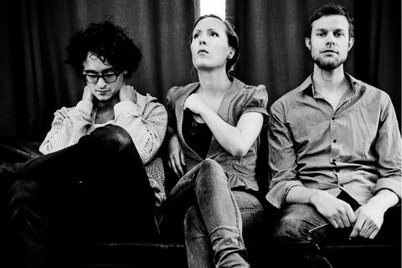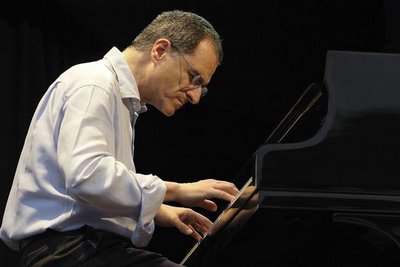theartsdesk in Copenhagen: The Copenhagen Jazz Festival | reviews, news & interviews
theartsdesk in Copenhagen: The Copenhagen Jazz Festival
theartsdesk in Copenhagen: The Copenhagen Jazz Festival
A heady mix of the up-and-coming and the internationally acclaimed
“In jazz music you have the freedom, you have the expression. You have the visceral and you have the intellectual. Everything can be expressed through jazz, and is expressed through jazz and through the medium of improvisation. This is the highest form of being able to create music.” Speaking at the opening press conference of this year's Copenhagen Jazz Festival, that definition of jazz from the 80-year-old saxophone colossus Sonny Rollins seems as self-contained and eloquent as any other I've heard.
Presenting the music in an amazing array of settings – from coffee houses, churches and city squares to concert halls, museums and galleries – where better to hear that mix of the visceral and the intellectual than Copenhagen. This year's festival is the biggest yet – with a series of concerts in Copenhagen Zoo even the animals are getting in on the act. It must be like organising the Jazz Olympics every year.
Watch Sonny Rollins speaking at the official press conference
“This year we have more than 1,150 concerts,” the festival project manager, Christian Dalgas, tells me. “And you may ask, do we have an audience for that? Yes, we have, actually. When I look at the daily schedule, they go to maybe five shows per day, these hardcore listeners. The most interesting part, from my point of view,” Christian continues, “is that all of the independent producers, if they don't book good music, people just walk out and go next door. There's jazz all over the city, so everybody is doing their very best to book a high-quality programme.”
At last year's festival I arrived suited and booted, a potentially fatal error on two counts. Firstly, by the time I'd walked from Copenhagen's Central Station to the festival office – a stroll of no more than 15 minutes – I felt like a boiled-in-the-bag dinner. And this was a very early morning stroll, too, before most of the city's residents had even got out of bed. When I first met Christian, he eyed me with a mixture of pity and incredulity. He was far too polite to say anything, but he clearly thought I was insane. Dude, the suit?
Secondly, I hadn't realised quite how many cobbled streets there were in Copenhagen, but – several pirouettes later - discovered that smooth leather soles took to them like oil to water. Well, at least it gave Copenhageners something to smile about.
This year I'd learnt my lesson. Regulation tourist attire: Toms slip-ons, shorts, T-shirt. As we disembarked from the plane and were ceremonially drenched by a vicious horizontal rain that came at us from a variety of angles, I made a mental note to check the weather before the next CJF.
Released earlier this year, I'd so enjoyed Marius Neset's Golden Xplosion that selecting this as my first gig was the easiest decision of the weekend. The rain was still coming down, and I half expected to be handed a life jacket upon arrival at this outdoor show. But joining a few other hardy souls (OK, I had a brolly), the 25-year-old Norwegian saxist succeeded in blowing the rain clouds away as, midway through his set, the clouds shift and a tiny ray of sunlight makes a welcome first appearance. The rest of the festival we basked in radiant sunshine.
Having to fill a piano chair vacated by Django Bates (who appeared on the recording) is a tough ask, but F-IRE Collective pianist Nick Ramm seemed entirely at home with the, at times, challenging keyboard charts. As on the album, the dynamic Phronesis team of Jasper Høiby (bass) and Anton Eger (drums) kept the engine room nicely stoked. Hearing the sax player's lightning-fast registral leaps in “Old Poison (XL)” and the enveloping stasis of “Epilogue” served to confirm the impression that Neset really has got something fresh to say on the instrument, and a compelling way of imparting it.
My second gig of the day featured one of the outstanding representatives of Danish jazz, Marilyn Mazur. Some percussionists like to add a little dash of exoticism to their kit: a bell tree here, a gong or two there. Mazur surrounds herself with a percussion forest: drums, gongs, bells, cymbals, wood blocks and countless other sound sources.
While most drummers can go through an entire gig without once shifting their cheeks from the drum stool, Mazur is never still, either flitting lightly amongst her percussion armoury or turning this way or that from her standard kit to quickly identify what to hit next. Appearing with her Celestial Circle quartet – pianist John Taylor, bassist Anders Jormin and vocalist Josefine Cronholm - Mazur is a colourist without aesthetic preconditions or boundaries. She doesn't sound or play quite like anyone else. Similarly, the subtlety and transparency of the quartet marks it out as quite unique.
 Two of the heaviest players on the scene, Brad Mehldau and Joshua Redman, have been part of each other's musical make-up for almost two decades. Characterised by amazingly detailed counterpoint, breathtaking modulations and a kind of easy familiarity, the duo's set at the Royal Theatre (pictured above) featured some sparkling originals including Mehldau's “The Falcon Will Fly Again” (from last year's Highway Rider) and “D Waltz”, plus Redman's “Note to Self”, although they seemed at their most vivid, their most adventurous and playful, in a rollicking ride through “Monk's Dream”. Nirvana's “Smells Like Teen Spirit” served as a bracing encore.
Two of the heaviest players on the scene, Brad Mehldau and Joshua Redman, have been part of each other's musical make-up for almost two decades. Characterised by amazingly detailed counterpoint, breathtaking modulations and a kind of easy familiarity, the duo's set at the Royal Theatre (pictured above) featured some sparkling originals including Mehldau's “The Falcon Will Fly Again” (from last year's Highway Rider) and “D Waltz”, plus Redman's “Note to Self”, although they seemed at their most vivid, their most adventurous and playful, in a rollicking ride through “Monk's Dream”. Nirvana's “Smells Like Teen Spirit” served as a bracing encore.
Day two, Saturday. One of the many delights of the Copenhagen Jazz Festival is being able to catch a homegrown group that wouldn't normally cross your radar. In the delightful courtyard of the Huset i Magstræde, the quirky, at times Satie-like sound world of Clara Bryld and her quintet - intermingling with the peeling of nearby church bells – combined to form one of those magical festival moments. Playing a mix of keys, guitar, percussion (lots), clarinet, trumpet, sax and three-part vocal harmonies to die for, tracks such as “Sunbeams, Ships and Snowflakes” and “Swim with the Sharks” were little tinkling toy boxes of delights. A couple of songs coasted out with just unaccompanied voices, an exquisite effect.
You hear quite a lot of church bells in Copenhagen. Our hotel was situated right opposite City Hall, whose bells begin at 8am and ring every quarter of an hour until midnight. The hotel kindly provided ear plugs, just in case you found the sound “disturbing”. I'm all for a bit of bell ringing myself. And in any case, they could have been filming Transformers 4 outside my window and I'd still have slept like a baby.
Herbie Hancock's show at the Opera House provided the greatest surprise of my trip to Copenhagen last year, and so it proved again this year, for rather different reasons. One of three artists in this year's Giant Jazz strand (Rollins and the great Bobby McFerrin were the other two), pianist Keith Jarrett has been working in a trio with bassist Gary Peacock and drummer Jack DeJohnette since Standards, Vol 1 in 1983.
Jarrett comes from the position that the stage is a sacred space and every cough or photograph somehow desecrates it, which I don't have a problem with. But then how does that square with him stopping the trio's first set in mid-flow to let us know that the acoustics of the Opera House were problematic. And not once, twice. The show mustn't go on, as it were. One rule for the audience, another for the artist hardly seems right (how about Double Standards as a title for the next album?). In a complete turnaround, the music-making in the second set was great, occasionally sublime.
 Sunday starts with a trip to the National Museum. Within the space of an hour, our brilliant guide whisks us through 14,000 years of Danish prehistory, from the Stone Age hunters of the Mesolithic period to the first kings of the Viking Age. Covering the period 1700-500 BC, the collection is particularly rich in Bronze Age exhibits including the Egtved Girl - buried in her oak coffin in 1370 BC - the elegantly ornamented Sun Chariot (a cast of a horse pulling the sun across the sky) and the incredible collection of lur horns dating from around 1000 BC.
Sunday starts with a trip to the National Museum. Within the space of an hour, our brilliant guide whisks us through 14,000 years of Danish prehistory, from the Stone Age hunters of the Mesolithic period to the first kings of the Viking Age. Covering the period 1700-500 BC, the collection is particularly rich in Bronze Age exhibits including the Egtved Girl - buried in her oak coffin in 1370 BC - the elegantly ornamented Sun Chariot (a cast of a horse pulling the sun across the sky) and the incredible collection of lur horns dating from around 1000 BC.
While the specific function of the lur (statue of lur horn players in City Hall Square, pictured left) has been open to debate, it's thought that they were used to create an atmospheric backdrop for Bronze Age religious rituals. Apparently the horns can produce between eight and 12 notes. So you might struggle with Richard Strauss's Horn Concerto No 2, but pretty impressive all the same.
Appearing in the beautiful surroundings of the National Gallery of Denmark in The State Sessions strand, the trio Equilibrium (pictured below right) were, for me, the revelation of this year's festival. Featuring Sissel Vera Pettersen (voice, sax, electronics), Mikkel Ploug (guitar) and Joachim Badenhorst (clarinet), the group has released two recordings to date - their eponymous debut album in 2009 and Walking Voices, released in April this year - both on the Canadian jazz/new music label Songlines.
 Capable of producing sustained lines of the utmost purity, wild ululations and the occasional melodic line that simply disappears off the treble clef, Pettersen's voice is an instrument of extraordinary flexibility. Building up ever more beguiling layers of vocal harmonies through the use of loops, the stunning - and unnamed - centrepiece of the trio's set referenced plainchant, John Cage and beyond, creating a rich yet surprisingly luminous contrapuntal web. It produced one of those powerful emotional jolts that really stirs the soul. They're yet to perform in the UK. This must be remedied.
Capable of producing sustained lines of the utmost purity, wild ululations and the occasional melodic line that simply disappears off the treble clef, Pettersen's voice is an instrument of extraordinary flexibility. Building up ever more beguiling layers of vocal harmonies through the use of loops, the stunning - and unnamed - centrepiece of the trio's set referenced plainchant, John Cage and beyond, creating a rich yet surprisingly luminous contrapuntal web. It produced one of those powerful emotional jolts that really stirs the soul. They're yet to perform in the UK. This must be remedied.
Watch Equilibrium perform "November"
 For my final concert I check out the brilliant Italian pianist Enrico Pieranunzi (pictured left). Playing in a trio with the Danish rhythm section of bassist Jesper Lundgaard and drummer Stefan Pasborg at the famed Copenhagen Jazzhouse, the pianist is on dazzling form, as revelatory on standards (“Someday my Prince Will Come”, “These Foolish Things”) as he is on newer material (Wayne Shorter's “Footprints” which the pianist recorded in the 1990s on one of his many releases for Soul Note). Pieranunzi has performed and recorded with a host of famous names – Chet Baker, Kenny Clarke, Johnny Griffin, Lee Konitz – and hearing him for the first time in the intimate space of the Jazzhouse was just about the perfect way to close the door on another exceptional festival.
For my final concert I check out the brilliant Italian pianist Enrico Pieranunzi (pictured left). Playing in a trio with the Danish rhythm section of bassist Jesper Lundgaard and drummer Stefan Pasborg at the famed Copenhagen Jazzhouse, the pianist is on dazzling form, as revelatory on standards (“Someday my Prince Will Come”, “These Foolish Things”) as he is on newer material (Wayne Shorter's “Footprints” which the pianist recorded in the 1990s on one of his many releases for Soul Note). Pieranunzi has performed and recorded with a host of famous names – Chet Baker, Kenny Clarke, Johnny Griffin, Lee Konitz – and hearing him for the first time in the intimate space of the Jazzhouse was just about the perfect way to close the door on another exceptional festival.
- Visit the Copenhagen Jazz Festival website
- See theartsdesk's listings of all UK festivals 2011
- See theartsdesk's listings of European festivals 2011
The official opening concert of the 2011 Copenhagen Jazz Festival
Add comment
The future of Arts Journalism
You can stop theartsdesk.com closing!
We urgently need financing to survive. Our fundraising drive has thus far raised £49,000 but we need to reach £100,000 or we will be forced to close. Please contribute here: https://gofund.me/c3f6033d
And if you can forward this information to anyone who might assist, we’d be grateful.

Subscribe to theartsdesk.com
Thank you for continuing to read our work on theartsdesk.com. For unlimited access to every article in its entirety, including our archive of more than 15,000 pieces, we're asking for £5 per month or £40 per year. We feel it's a very good deal, and hope you do too.
To take a subscription now simply click here.
And if you're looking for that extra gift for a friend or family member, why not treat them to a theartsdesk.com gift subscription?
more New music
 Album: Mark Stewart - The Fateful Symmetry
The Bristol agit-prop hero on philosophical form on his final album
Album: Mark Stewart - The Fateful Symmetry
The Bristol agit-prop hero on philosophical form on his final album
 First Person: country singer Tami Neilson on the superpower of sisterhood
The Canadian-born, New Zealand-based artist on how women have empowered her career
First Person: country singer Tami Neilson on the superpower of sisterhood
The Canadian-born, New Zealand-based artist on how women have empowered her career
 Album: Gwenno - Utopia
The Welsh musical explorer surveys her life
Album: Gwenno - Utopia
The Welsh musical explorer surveys her life
 Album: Olafur Arnalds and Talos - A Dawning
Shimmery, shiny Icelandic-Irish ambience steeped in beauty
Album: Olafur Arnalds and Talos - A Dawning
Shimmery, shiny Icelandic-Irish ambience steeped in beauty
 Sabrina Carpenter, Hyde Park BST review - a sexy, sparkly, summer phenomenon
The Summer of Sabrina continues to shine bright
Sabrina Carpenter, Hyde Park BST review - a sexy, sparkly, summer phenomenon
The Summer of Sabrina continues to shine bright
 Music Reissues Weekly: Motörhead - The Manticore Tapes
Snapshot of Lemmy and co in August 1976 proves fascinating
Music Reissues Weekly: Motörhead - The Manticore Tapes
Snapshot of Lemmy and co in August 1976 proves fascinating
 Album: Barry Can't Swim - Loner
Dive in to some sizzling summer dance music
Album: Barry Can't Swim - Loner
Dive in to some sizzling summer dance music
 Glastonbury Festival 2025: Five Somerset summer days of music, controversy and beautiful mayhem
The full, brain-frazzling, immersive deep dive into Worthy Farm's music and arts spectacular
Glastonbury Festival 2025: Five Somerset summer days of music, controversy and beautiful mayhem
The full, brain-frazzling, immersive deep dive into Worthy Farm's music and arts spectacular
 Album: Kesha - .
After a decade of tribulation, a new beginning matches stadium heft to club-pop bounce
Album: Kesha - .
After a decade of tribulation, a new beginning matches stadium heft to club-pop bounce
 Album: Claudia Brücken - Night Mirror
The Propaganda singer returns with an album of elegant, varied grown-up pop
Album: Claudia Brücken - Night Mirror
The Propaganda singer returns with an album of elegant, varied grown-up pop
 Album: Mocky - Music Will Explain (Choir Music Vol. 1)
Is the Canadian polymath hiding behind his exquisite production and arrangement skill?
Album: Mocky - Music Will Explain (Choir Music Vol. 1)
Is the Canadian polymath hiding behind his exquisite production and arrangement skill?
 Album: Brìghde Chaimbeul - Sunwise
A singular sonic auteur reshapes traditional Celtic music
Album: Brìghde Chaimbeul - Sunwise
A singular sonic auteur reshapes traditional Celtic music

Comments
...